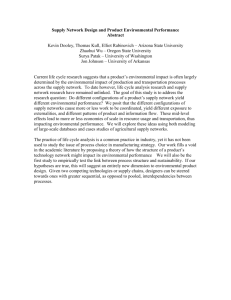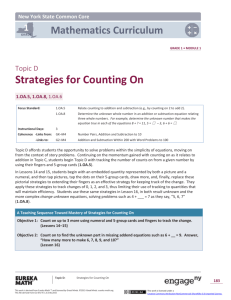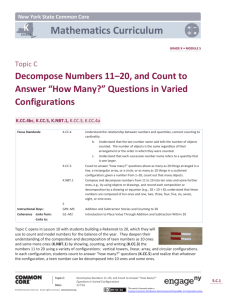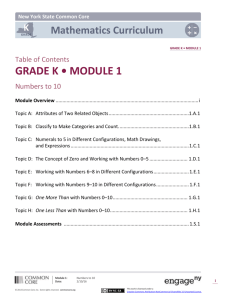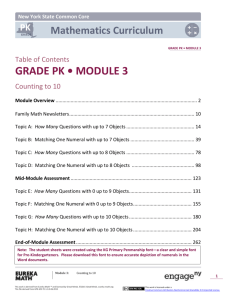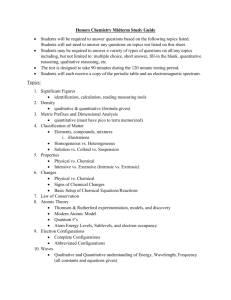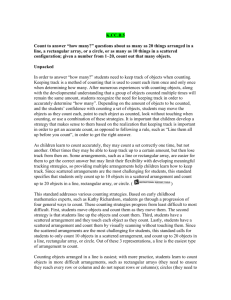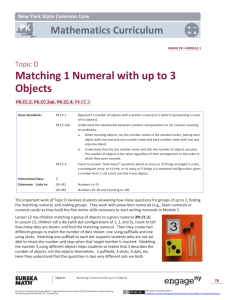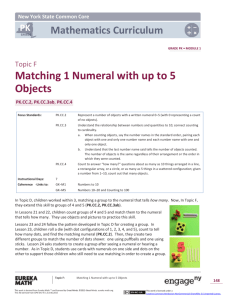Kindergarten Mathematics Module 1, Topic E
advertisement
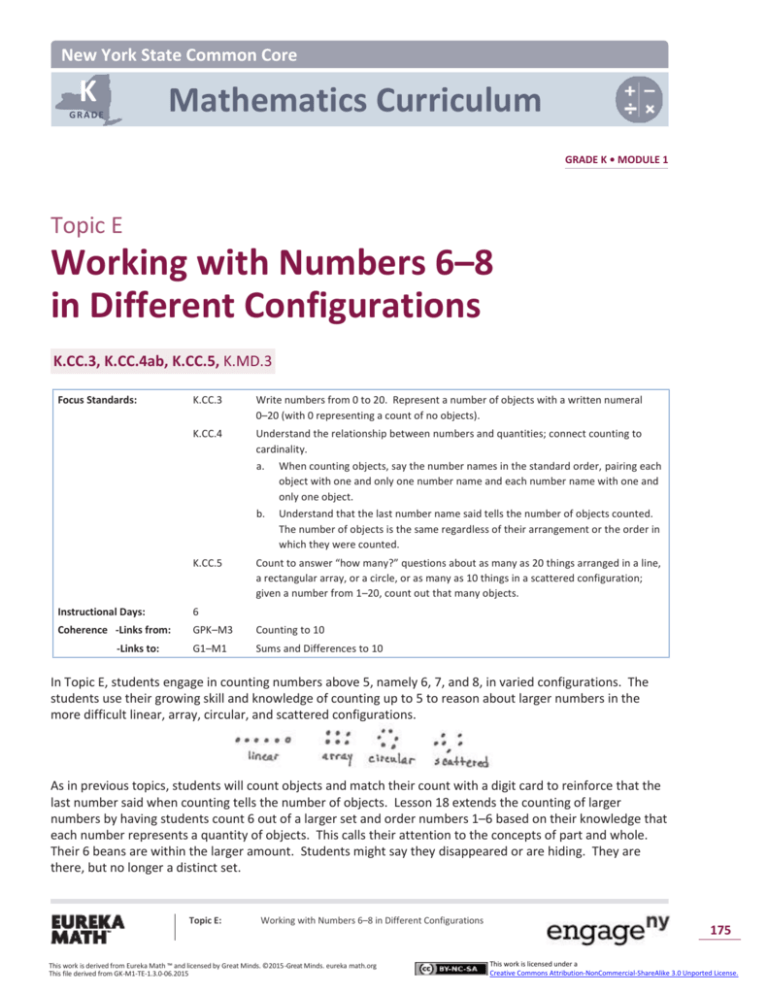
New York State Common Core K Mathematics Curriculum GRADE GRADE K • MODULE 1 Topic E Working with Numbers 6–8 in Different Configurations K.CC.3, K.CC.4ab, K.CC.5, K.MD.3 Focus Standards: K.CC.3 Write numbers from 0 to 20. Represent a number of objects with a written numeral 0–20 (with 0 representing a count of no objects). K.CC.4 Understand the relationship between numbers and quantities; connect counting to cardinality. K.CC.5 a. When counting objects, say the number names in the standard order, pairing each object with one and only one number name and each number name with one and only one object. b. Understand that the last number name said tells the number of objects counted. The number of objects is the same regardless of their arrangement or the order in which they were counted. Count to answer “how many?” questions about as many as 20 things arranged in a line, a rectangular array, or a circle, or as many as 10 things in a scattered configuration; given a number from 1–20, count out that many objects. Instructional Days: 6 Coherence -Links from: GPK–M3 Counting to 10 G1–M1 Sums and Differences to 10 -Links to: In Topic E, students engage in counting numbers above 5, namely 6, 7, and 8, in varied configurations. The students use their growing skill and knowledge of counting up to 5 to reason about larger numbers in the more difficult linear, array, circular, and scattered configurations. As in previous topics, students will count objects and match their count with a digit card to reinforce that the last number said when counting tells the number of objects. Lesson 18 extends the counting of larger numbers by having students count 6 out of a larger set and order numbers 1–6 based on their knowledge that each number represents a quantity of objects. This calls their attention to the concepts of part and whole. Their 6 beans are within the larger amount. Students might say they disappeared or are hiding. They are there, but no longer a distinct set. Topic E: Working with Numbers 6–8 in Different Configurations This work is derived from Eureka Math ™ and licensed by Great Minds. ©2015 -Great Minds. eureka math.org This file derived from GK-M1-TE-1.3.0-06.2015 175 This work is licensed under a Creative Commons Attribution-NonCommercial-ShareAlike 3.0 Unported License. NYS COMMON CORE MATHEMATICS CURRICULUM Topic E K 1 Lesson 19 looks at numbers 5–7. Students count on their fingers from 1 to 7 and connect to 5-group images (for example, five fingers on one hand). “7 is 5 and 2. Here it is on my fingers.” Reasoning about numbers 6–8 highlights the importance of the 5-unit. Lesson 20 explores the number 7. Students reason about strategies to count 7 objects in circular and scattered configurations. Partners might look at each other’s 7 objects, one in array formation and the other in scattered formation, and discuss similarities and differences between their sets. This concept is continued in Lesson 21 with the number 8. Students also consider the size of the objects being counted by comparing their 8 objects to a friend’s. For example, “My cotton balls are bigger than your cubes, but when we count them, we both have eight!” The last lesson in this topic asks students to arrange and strategize how to count eight beans in a circular (around a cup) and scattered configuration. They also write the numeral 8 and find a path through the scatter set, comparing their paths with a partner. A Teaching Sequence Toward Mastery of Working with Numbers 6–8 in Different Configurations Objective 1: Count 4–6 objects in vertical and horizontal linear configurations and array configurations. Match 6 objects to the numeral 6. (Lesson 17) Objective 2: Count 4–6 objects in circular and scattered configurations. Count 6 items out of a larger set. Write numerals 1–6 in order. (Lesson 18) Objective 3: Count 5–7 linking cubes in linear configurations. Match with numeral 7. Count on fingers from 1 to 7, and connect to 5-group images. (Lesson 19) Objective 4: Reason about sets of 7 varied objects in circular and scattered configurations. Find a path through the scattered configuration. Write numeral 7. Ask, “How is your seven different from mine?” (Lesson 20) Objective 5: Compare counts of 8 in linear and array configurations. Match with numeral 8. (Lesson 21) Objective 6: Arrange and strategize to count 8 beans in circular (around a cup) and scattered configurations. Write numeral 8. Find a path through the scatter set, and compare paths with a partner. (Lesson 22) Topic E: Working with Numbers 6–8 in Different Configurations This work is derived from Eureka Math ™ and licensed by Great Minds. ©2015 -Great Minds. eureka math.org This file derived from GK-M1-TE-1.3.0-06.2015 176 This work is licensed under a Creative Commons Attribution-NonCommercial-ShareAlike 3.0 Unported License.
